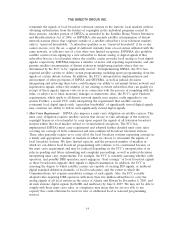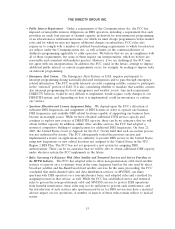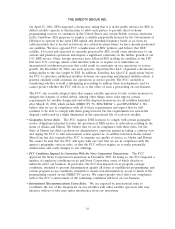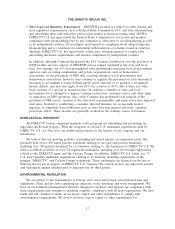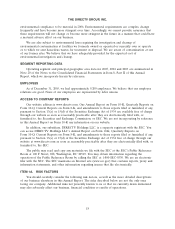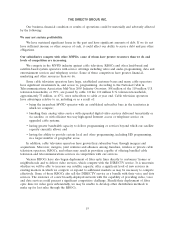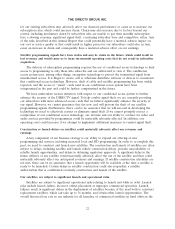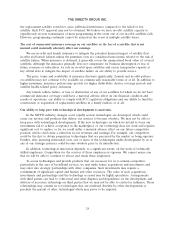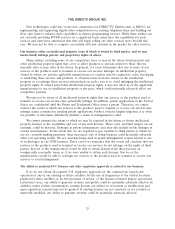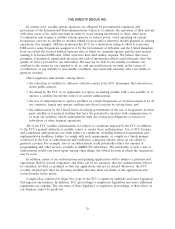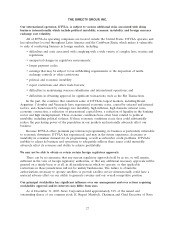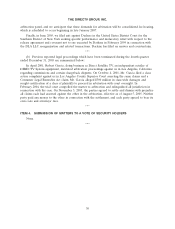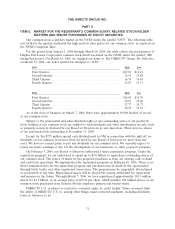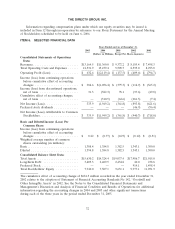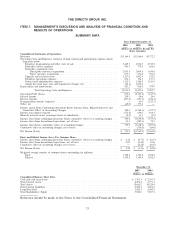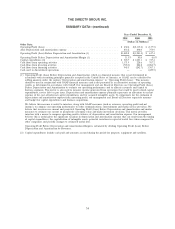DIRECTV 2005 Annual Report Download - page 37
Download and view the complete annual report
Please find page 37 of the 2005 DIRECTV annual report below. You can navigate through the pages in the report by either clicking on the pages listed below, or by using the keyword search tool below to find specific information within the annual report.THE DIRECTV GROUP, INC.
the replacement satellite would not cause additional interference compared to the failed or lost
satellite. Such FCC approval may not be obtained. We believe we have in-orbit satellite capacity to
expeditiously recover transmission of most programming in the event one of our in-orbit satellites fails.
However, programming continuity cannot be assured in the event of multiple satellite losses.
The cost of commercial insurance coverage on our satellites or the loss of a satellite that is not
insured could materially adversely affect our earnings.
We use in-orbit and launch insurance to mitigate the potential financial impact of satellite fleet
in-orbit and launch failures unless the premium costs are considered uneconomic relative to the risk of
satellite failure. When insurance is obtained, it generally covers the unamortized book value of covered
satellites. Although the insurance generally does not compensate for business interruption or loss of
future revenues or subscribers, we rely on in-orbit spare satellites and excess transponder capacity at
key orbital slots to mitigate the impact of satellite failure on our ability to provide service.
The price, terms and availability of insurance fluctuate significantly. Launch and in-orbit policies
on satellites may not continue to be available on commercially reasonable terms or at all. In addition to
higher premiums, insurance policies may provide for higher deductibles, shorter coverage periods and
satellite health-related policy exclusions.
Any launch vehicle failure, or loss or destruction of any of our satellites for which we do not have
commercial insurance coverage could have a material adverse effect on our financial condition and
results of operations, our ability to comply with FCC regulatory obligations and our ability to fund the
construction or acquisition of replacement satellites in a timely fashion, or at all.
Our ability to keep pace with technological developments is uncertain.
In the MVPD industry, changes occur rapidly as new technologies are developed, which could
cause our services and products that deliver our services to become obsolete. We may not be able to
keep pace with technological developments. If the new technologies on which we intend to focus our
investments fail to achieve acceptance in the marketplace or our technology does not work and requires
significant cost to replace or fix, we could suffer a material adverse effect on our future competitive
position, which could cause a reduction in our revenues and earnings. For example, our competitors
could be the first to obtain proprietary technologies that are perceived by the market as being superior.
Further, after incurring substantial costs, one or more of the technologies under development by us or
any of our strategic partners could become obsolete prior to its introduction.
In addition, technological innovation depends, to a significant extent, on the work of technically
skilled employees. Competition for the services of these employees is vigorous. We cannot assure you
that we will be able to continue to attract and retain these employees.
To access technologies and provide products that are necessary for us to remain competitive,
particularly in the area of broadband services, we may make future acquisitions and investments and
may enter into strategic partnerships with other companies. Such investments may require a
commitment of significant capital and human and other resources. The value of such acquisitions,
investments and partnerships and the technology accessed may be highly speculative. Arrangements
with third parties can lead to contractual and other disputes and dependence on the development and
delivery of necessary technology on third parties that we may not be able to control or influence. These
relationships may commit us to technologies that are rendered obsolete by other developments or
preclude the pursuit of other technologies which may prove to be superior.
24


